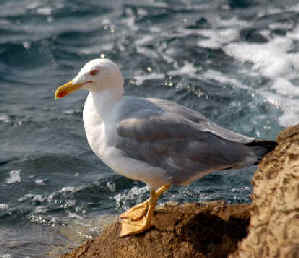
E-mail: font@focusonnature.com
Phone: Toll-free in USA 1-888-721-3555
or 302/529-1876
 |
PO Box 9021,
Wilmington, DE 19809, USA E-mail: font@focusonnature.com Phone: Toll-free in USA 1-888-721-3555 or 302/529-1876 |
THE
FOCUS ON NATURE TOUR IN THE CANARY
ISLANDS
June 2009

The Yellow-legged Gull
is a common bird of the Canary Islands
Links:
List of Birds & Other Nature during the FONT tour in the Canary Islands - June 2009
Cumulative Lists of Birds & Other Wildlife of the Canary Islands
Cumulative Lists of Birds & Other Wildlife during FONT Tours in Spain & the Canary Islands
Upcoming FONT Birding & Nature Tours in Europe
The Canary
Islands is an archipelago of 7 main islands, off the northwest coast
of Africa, but part of Spain. Africa, however, is 10 times closer to the
Canaries than is the Iberian Peninsula.
But a part of Spain the Canaries are, having been so since the 15th century.
Those who lived on the islands prior to that were known as the Guanches. When
the Spaniards arrived, the native people put up a fierce fight but were
eventually subdued. Some were deported. Some intermixed with the Spaniards.
Little trace is left of them today.
All that's known has been gleaned from archaeological remains or the written
journals of the conquerors. It is not known where the Guanches came from, or why
in the 15th century they still lived in the Stone Age.
They were close to 7 feet tall. To them the use of metal was unknown, and they
know nothing about boat building.
Theories say that they were fair-complexioned Berbers from Africa. But what can
not be explained is how they would have arrived by sea without boats. Another
theory claims that the Canary Islands are the peaks above water after the
continent of Atlantis sunk. So, with that, the early inhabitants, mountain
people, would have been stranded in an ocean environment and naturally would
have known nothing about sea travel.
Now, let it be said that the Canary Islands are, these days, visited by many
people known as tourists, who travel from mostly throughout Europe.
For us, it's the diversity of the nature of the archipelago that's the main
attraction. The flora has been evolving on the islands for millions of years,
and now there are a large number of plant species found nowhere else in the
world.
Fossil evidence shows that on the Canaries the legendary Dragon Tree, Dracaena
draco (one of which was said to be 6,000 years old, prior to perishing in a
hurricane in 1867), the Canary laurels, and some indigenous fern species have
been there up to 20 million years! Their nearest relatives are found today in
South America and Africa.
Two species of birds, endemic to the Canaries, have lingered on during the
many years since the Age of the Dinosaurs, only occurring in the laurel forests
of the islands. Both of them are Pigeons, the Bolle's and the Laurel.
The total flora of the Canary Islands numbers some two thousand species. A
number of these, as just noted, are relics of a previously much more widespread
vegetation, which has gradually shrunk, due to the drying out of the area
now occupied by the Sahara Desert (only about 80 miles from the easternmost
of the Canaries), and the southward movement historically of a glacial
climate caused by the Ice Ages.
Currently, the 7 main islands of the Canarian
archipelago are each quite different from each other. In general, the
eastern islands are more arid, and the western islands are more lush.
Much of the eastern island known as Lanzarote
is volcanic (more about this follows).
Much of the other sparsely-populated eastern island called Fuerteventura
is desert.
To the west, the island of Tenerife has a
completely different profile, from the rocky shore up to a layer of cloud, that
lies like a collar, around the magnificent peak of Monte
Teide, over 12,000 feet above sea level. That mountain is higher than
any in mainland Spain. Its slopes are famous for its unique alpine flora.
Birds on Tenerife are notably different than those on other islands in the
Canaries, particularly those on Lanzarote and Fuerteventura to the east.
On Tenerife, in various habitats, including
the pine and laurel forests, there are these species of birds, either endemic to
the Canaries themselves, or to the Macaronesian region:
the attractive Blue Chaffinch, the Canary (the wild descendent
of caged Canaries), a kinglet or goldcrest type of bird, a
local resident Chiffchaff, a swift, and the two species of wild pigeons
already noted.
There are endemic subspecies also on Tenerife. including those of the European
Robin, European Blackbird, Great Spotted Woodpecker, Chaffinch (1 of 3
distinctive subspecies in the Canaries), and the African Blue Tit (1
of 4 subspecies in the Canary Islands).
Of the 4 Canarian Islands that we've visited
during FONT tours (Tenerife, La Gomera,
Fuerteventura, and Lanzarote),
it is perhaps Lanzarote that is the most
exotic, or it might even be said, sensational. Without any hyperbole, that
distinctive island is certainly interesting.
Much of it is a "desert" of black volcanic ash, where the ground still
smolders beneath the surface. Parts of the island are treeless - a lunar
landscape.
This desolate, yet majestic terrain is the result of 18th and 19th Century
volcanic eruptions that covered much of the small island in lava and ash and
left it as a desert. It was in 1730 that a succession of violent eruptions began
that lasted for 6 years, and left the burned-out husks of volcanoes that dot the
plain to this day.
Today, it requires a considerable effort to conjure an imagination to picture a
fertile agricultural plain that existed in the area before 1730.
One would think that animal and plant life could not possibly survive in such
inhospitable surroundings, lacking water and buffeted by desert winds (as
noted Lanzarote is only about 80
miles from the African Sahara). And yet, life does exist.
The people of Lanzarote created an ingenious
system to make life possible on the island. They observed how the volcanic ash
absorbed the early morning dew. Plowing the earth with the aid of dromedaries
(one-humped camels which are the island's typical beast of burden), they
planted crops and covered the ground with a layer of volcanic ash. They dug
shallow holes into the bleak earth (adding man-made craters to the already
crater-pocked island) and planted grape vines, once more carefully spreading
black ash over the earth. Then they built miniature stone walls around each
plant to protect against the winds. And then the crops thrived. The labor has
been a work of art with no mechanical aid.
Today the blackened earth of Lanzarote alternates with vineyards and plantings
of melons, figs, and tomatoes to create at places away from the volcanic rubble,
"a sea of green".
Flat-roofed, all-white houses, in the scattered small villages, stand out in
stark contrast to the dark terrain of the land. Along the coast, the hulls of
the fishing boats are also white.
Some particular places on Lanzarote are as
striking as the general scene on the island.
In the Timanfaya National Park (whose
symbol is a menacing devil), there's the Montana de
Fuego (or "Mountain of Fire"). In the 18th Century,
it unexpectedly arose from the earth in a tumultuous eruption of molten lava.
Today, although the volcano is now dormant, the searing heat just a foot or so
below the surface is enough to vaporize water, fry an egg, or light a fire. A
restaurant on that mountain serves food grilled with volcanic heat.
The summit of that mountain can be reached on camelback (or more precisely,
on the one-humped dromedaries already mentioned). Those who'd dislike the
swaying gait of the camels can walk.
From the summit one can look at an amazing sight of more than 30 volcanic cones
whose craters glow with iridescent light and glittering hues of pastels, ochres,
and blues created by the soil's iron particles.
Those more than 30 volcanoes (actually 36) are within a triangle of 8
kilometers (5 miles). Colors were just mentioned, but to say again: one
of the volcanoes is yellow, another is red and the ground is black or burnt
sienna. The shadows of the deepest craters are an intense purple. But not a
green leaf is visible in the area, just the gray-green of lichen on some
northern slopes.
Seaside, not far from the "Mountain of Fire", there are salt pans that
contrast strikingly with the blue sea and blackened hills. Along the edge of the
coastal lagoon by those salt pans, we saw Black-winged Stilts (apparently
nesting there), a Eurasian Oystercatcher, Kentish Plovers, Southern
Gray Shrike, and Berthelot's Pipit. Also, there, running so quickly
on the dry ground from one low bush to another, a diminutive animal, the Canary
Shrew, was seen.
Shrews are fascinating little animals. They evolved, it's been
determined, 45 million years ago, and have remained unchanged for at least 10
million years. They are among the most ancient and widespread of the world's
mammals. There are, in all, 335 species of shrews. Many of them are
localized, as is the Canary Shrew, which occurs only on 2 of the Canary
Islands: Fuerteventura and
Lanzarote.
At the north end of Lanzarote, there's a
wondrous cave, called in Spanish "Las Cuevas de los Verdes". In it,
there's an all-white and blind 1/2 inch-long crab, Munidopsis
polymorpha, which has not been discovered anywhere else in the world.
It's in northern Lanzarote where the
majority of the island's rare and endemic plant species can be found,
notably the highly restricted Echium decaisnei purppuriense and
the composite Argyranthemum ochroleucum, which is endemic to
Lanzarote and resembles a ragwort.
At sea level on the island there are two yellow-flowered members of the daisy
family which are confined to the two eastern Canary Islands (of Lanzarote
& Fuerteventura):
the fleabane Pulicaria canariensis, and Astericus
schultzii.
Cliff-tops in northern Lanzarote harbor the umbellifer Ferula
lancerottensis, found only at one locality, and the more widespread lavender
species Lavandula pinnata.
A particularly spectacular spot at the north end of Lanzarote
is called "Mirador del Rio".
There, at the top of a very high seaside cliff, it's not a river below, but a
strait between Lanzarote and the offshore island called Isla Graciosa.
It was at that high cliff where we saw a quick-flying Eleonora's Falcon.
And a Bulwer's Petrel was seen there in flight at daybreak. They nest in
that area, as do Cory's Shearwaters and Madeiran (or Band-rumped)
Storm Petrels.
Along a small country road atop the cliff, also early during the morning when we
saw the Bulwer's Petrel, we saw, walking ahead of us on the road, an Algerian
Hedgehog.
Other notable bird sightings during our June 2009 tour in the Canary Islands
included:
3 Houbara's Bustards on Lanzarote,
with Stone-Curlews nearby,
a family of Cream-colored Coursers on Fuerteventura
(2 parents and their 2 nearly-grown offspring), and Egyptian Vulture
and the rare Canary Islands Chat also on that island,
while back on Lanzarote, there were dozens,
yes a few dozen, Barbary Partridges one morning at a golf course. Also
there at that golf course, we saw Hoopoes and numerous Berthelot's
Pipits on the "greens" (at a habitat quite unusual on that dry
island).
Another bird with the adjective "Barbary" was seen, and
enjoyed, during our '09 Canary Islands tour:
at a high cliff on the island of Tenerife,
we saw the rarest of the raptors of the islands, the Barbary Falcon.
So dramatic it was in flight as it appeared to go without effort from the base
to the top of the large cliff.
At the beginning of this narrative, there's a link to a complete listing of the
birds and other nature that we saw during our June '09 tour in Canary Islands of
Spain, off the northwest coast of Africa. What a place!